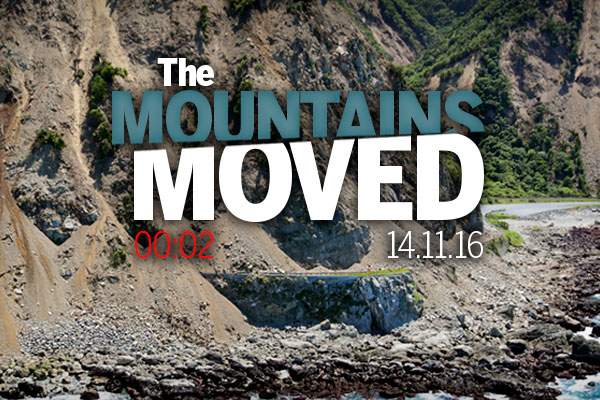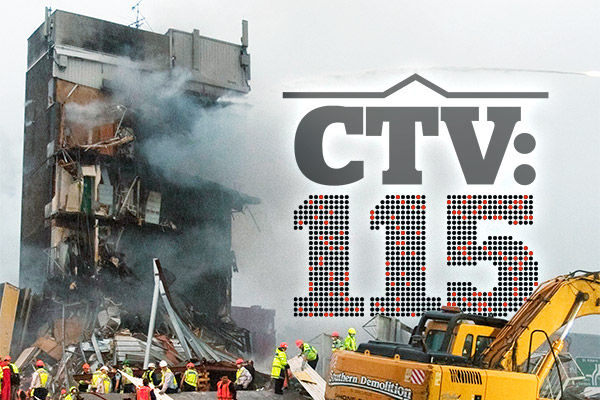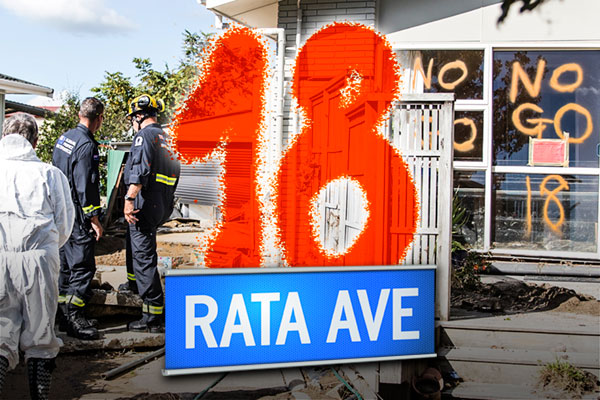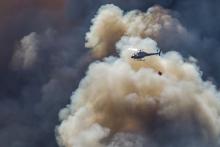On December 15, Kaikōura's year in virtual isolation ends. After the major earthquake in November 2016, State Highway 1 either side of the town was beset by land slips, closed to the north, just barely open to the south. Finally, the connection is restored.
(This article was first published in November 2017 to mark the anniversary of the earthquake.)
In the early morning light, the sky is flushed with pastels of red and blue which merge gently with the deep azure of the Pacific Ocean. Huge hills sprout from the shoreline, almost sheer and thickly coated in the deep greens of native bush.
In the sliver of space in between, the fragile road is barely discernible. It stands out at the moment, but only because of the countless men and machinery peppered along its length, bringing it back from oblivion. One year ago this particular stretch of State Highway 1 around Kaikōura was nearly wiped out.
A magnitude-7.8 earthquake shook loose more than one million cubic metres of earth from the hills, burying the road, destroying bridges and ripping railway lines out into the sea. More than 40 separate landslides fell in all, closing the road in two places: a 21km stretch north of Kaikōura and an 8km one to the south.

The process all but cut the town off from the world. A lifeline was quickly re-established via the Inland Road to Waiau, but it wasn't the same.
The southern side of the SH1 work is now open, depending on conditions, from Fridays to Mondays. The northern tract, on the road to Picton, is still closed, severing the flow of tourists that kept the town alive and diverting trucks from a vital transport link between Christchurch and the North Island. For a year, those trucks have instead had to take an alternative route over the Lewis Pass, a longer and more difficult drive estimated to cost the freight industry $2.7 million a week.
Against these odds, those charged with rebuilding the stricken highway have set themselves a deadline: reopen SH1 north of Kaikōura by December 15. A year, a month and a day to do the best part of a job which under normal circumstances should take a decade.
The task has fallen to the North Canterbury Transport Infrastructure Recovery alliance (NCTIR), made up of more than 100 organisations including the NZ Transport Agency (NZTA), KiwiRail and a range of contractors.
The group is well-resourced, with $812 million of Government money at its disposal, but cash alone cannot overcome the natural barriers it faces. The work site is long, narrow and remote. Moving people and equipment through construction zones is the only option and it can make for slow going. Just $351m has been spent so far.
On top of that, the worst damage on the northern section – which needs the most resources – is right in the middle. About 110,000 cubic metres of slip material fell at Ōhau Point, home of the famous seal colony. Rather than clear it all and repair the old highway, road builders are in some places making use of a few precious extra metres of seabed uplifted by the earthquake to build a new route.
This new road needs protecting. In all, 2.5km of seawall will be built to shield it from the ocean. Seven thousand concrete blocks, each weighing more than five tonnes, need to be craned into place. About 4500 of them will be at Ōhau Point. Above the new road, the outer edge of the old highway is piled high to catch any further rocks that fall from the gaping slips. Slip material has been used to build access roads outside the seawalls. They will be dug out when the work is done, leaving the coast looking like it was never there.
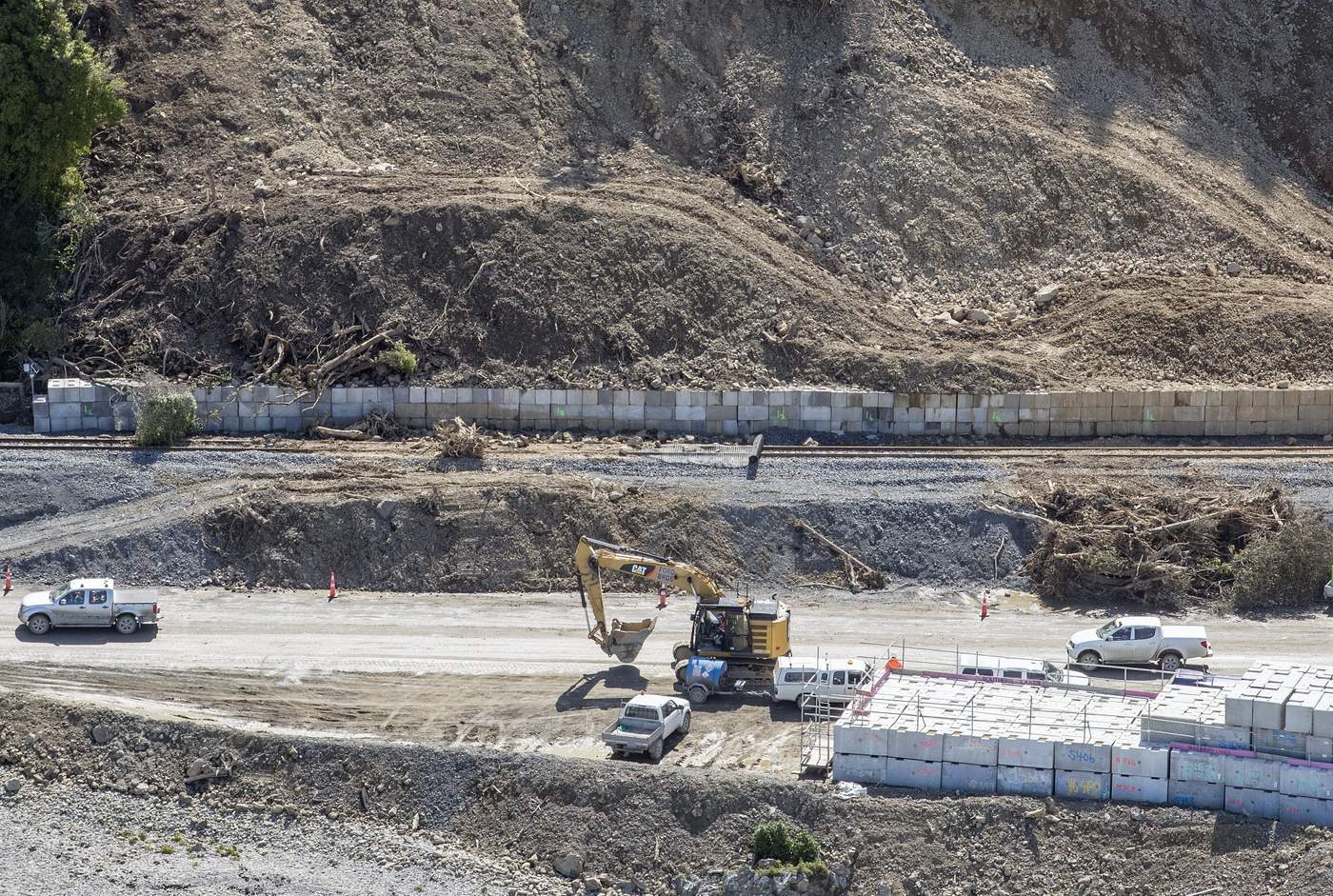
Workers clear rubble from SH1 north of Kaikoura. PHOTO: IAIN MCGREGOR/STUFF
Clark Butcher manages the section of the project north of Ōhau stream. The slips he is charged with clearing are enormous, but still dwarfed by the might of Ōhau Point.
The site is less complex than others along the road, but crews were only given access to parts of it a few weeks ago. Most of the work is building seawalls, which will be at about half of their final height when the highway reopens in December.
Butcher has up to 130 workers under his command. He says the hardest part of his job is coordinating all the resources, like the 35 trucks continually making the 45-minute trip from the Clarence River to provide fill that goes behind the seawalls.

Clark Butcher started a beard when he took on the site: "It'll just keep growing until that road's open." PHOTO: DAVID WALKER/STUFF
Previously, Butcher worked on the stretch of railway from Ōaro to Clarence – basically the entire length of the damaged route either side of Kaikōura. When he took the job, he decided to stop shaving until the line reopened.
That beard went back in September, when the first freight train rolled down the line. A fresh one has sprouted in its place. It will grow unkempt until the road is opened to the public.
It was a scene of perverse irony: a few days after Kaikōura was devastated by the earthquake, still cut off to all but sea or air travel, residents gathered to receive free petrol vouchers as part of the emergency response.
Danny Smith, soon to be the town's earthquake recovery manager, saw a guy he knew.
"He said, 'I don't know what I want this for, I've got nowhere to go. I can only travel about 15 kays."
So began Kaikōura's difficult post-earthquake relationship with the rest of New Zealand. Once the perfect midpoint on SH1 between Picton and Christchurch, it now sits an outpost at the wrong end of a ragged, windy, substandard loop road that since November 14 last year is its only tangible connection to the outside world.
Two key parts of that route – SH1 south to Christchurch and the Inland Rd to Waiau – were impassable after the earthquake. Both were cleared by Christmas but are still encumbered by single lanes, detours, partial closures and endless stop-go signs. For Kaikōura residents, that situation is, at best, tolerable. Many of them have December 15 – the elusive reopening date – etched into their minds.
"It's just a totally different perception when you have to drive to a destination and drive the same way back from the destination to leave," Encounter Kaikōura business manager Lynette Buurman says.

Encounter Kaikoura business manager Lynette Buurman. PHOTO: IAIN MCGREGOR/STUFF
She estimated the business, which specialises in dolphin and albatross viewing boat tours, garnered half its business from drive-through traffic.
A good chunk of that is foreign visitors, who account for about 80 per cent of Kaikōura's tourism and, when they arrive off the ferry in Picton, now head for Nelson and the West Coast rather than brave the seven-hour trek to get to a town that is, technically, only about 200km away.
"We need [the road] open," Destination Kaikōura manager Glenn Ormsby says. "We can't wait. If it's closed in the evenings, because of danger, so be it. But it needs to be open. We need that access going north.
"A lot of operators I talk to are telling us their forward bookings are looking very good for summer. They're way up. So if it's not open . . ."
. . . That's bad for everyone. A soft reopening is a whole lot better than none at all.
Kaikōura resident Sue Posa travels to Christchurch once every two months to visit her daughter.
"It's trying at times," she says, "I know some people that haven't left yet.
"The frustrating thing is if something breaks you've got nowhere to replace it. You have to rely on people bringing it in for you. A couple of weeks ago someone needed a washer for their tap. No-one in town had a washer."

Kaikoura resident Sue Posa: “I know some people that haven’t left yet.” PHOTO: IAIN MCGREGOR/STUFF
Still, mission accomplished on December 15 does not spell relief for everyone. Dave Stanford, owner of the Lazy Shag Backpackers, is operating on a fraction of his pre-earthquake business. He does not expect the rest of it to return next month.
"Our clientele is Kiwi Experiences, Stray Travel: Big [bus] companies. They need reliability. They can't drop all their beds in Nelson and then say there's been two days of rain in Kaikōura, the roads are closed.
"Until [NCTIR] can actually open the road constantly we're in the same position".

Lazy Shag Backpackers owner Dave Stanford. PHOTO: MICHAEL WRIGHT/STUFF
Craypot Cafe owner Kevin Brown only reopened his business three months ago. Until then it was more profitable to rent the space to an insurance company that needed a shop front in town. Even now, he is still just "treading water".
"The end is in sight. [But] what's open? A couple of convoys each way? The true getting back to normal is a year away."
Normal came to Kaikōura for one weekend last month when the town's annual Seafest drew a comparable crowd to 2016, packed out local accommodation and forced a gate closure – for capacity reasons – on the Saturday afternoon.
The event nearly didn't happen, Mayor Winston Gray says, as organisers feared it would be hobbled by rain or a road closure. Several stalls cancelled in the week before the event, he says, citing access issues.
"That was quite difficult compared to most years. But it was really surprising, the support we got for that."
It used to be a 15-minute drive. Now it takes 11 hours.
The closure of SH1 has affected everyone in the area north of the cordon, but beekeepers Grant and Bridgette Slade's mammoth detour might be a record.
The family-owned business, Clarence River Harvest, is based just to the north of its namesake river, where the road closes. It has about 600 hives on the south side, around Kaikōura and in the Blue Duck Valley, accessible only by driving north to Blenheim, down through the Nelson Lakes, back over the Lewis Pass and up the Inland Rd to Kaikōura.
"It's absolutely devastating," Grant Slade says, "You think you could be home in 15 minutes. But instead you have to drive all night."

Ayden Slade, tends to the beehives run by the family company, Clarence River Harvest. PHOTO: SUPPLIED
In the past three weeks he has made the return journey three times. The drive is costly for the business and exhausting for Slade. Bridgette Slade estimates additional bills since the earthquake at $50,000, including flights to and from Kaikōura for staff and accommodation in the town.
Like everyone else in the area, the Slades are holding out for reopening day. Where Kaikōura has partial SH1 openings to the south and the Inland Rd loop alternative, Clarence is at the end of a very long dead-end street. The road cones, heavy machinery and workers clad in high-vis bring a busyness, but it is artificial. At night, the south Marlborough towns of Seddon and Ward are eerily quiet.

Mike Hole enjoys the peace. And during the day his Premier Motor Car business in Seddon is full of vehicles waiting to be serviced. The business had its best month since 2013 this August, boosted by roading contractors.
"I think in another six months, when the road's open again and it's all settled, if we don't get any more big smacks [life will] be back to normal," he says.
Hole lives in Ward. The town of around 900 people was hammered in the earthquake. It lost its only pub, houses had to be demolished, and its biggest employer, Burkhart Fisheries, faces an uncertain future.
Dennis Burkhart, who runs the company with his brother Trevor, says the road closure combined with seabed uplift at nearby Ward Beach has had a devastating effect. The company cannot launch its boats there, where it caught most of its crayfish. Contractors can supply some south of Waipapa Point, inside the cordon, but they wouldn't survive the 11-hour drive to Ward, so must be flown to Auckland for processing. Paua caught in the area can still be taken to the Ward factory, but the disruption has essentially turned Burkhart Fisheries into a non-profit organisation in 2017.

Trevor and Dennis Burkhart with a crayfish at the Ward factory. PHOTO: SCOTT HAMMOND/STUFF
"We don't know how lucky we were," Dennis Burkhart says.
Like Seddon, earthquake recovery has had an upside in Ward. Burkhart and wife Barbara also own Flaxbourne Services, a roadside cafe and kind of general store in the town. Patronage has increased handsomely this year from the presence of road workers.
More than 75 metres above the road, on ropes anchored at more than that height again, a man in full-length orange hi-vis clothing hangs below a mechanical drill boring into the grey rock of the cliff.
Hundreds of fluorescent dots peppered on the cliff around him show the scale of the job he and others have ahead of them. Each dot marks where a hole will be drilled, some up to 6m deep. Rock anchors will be placed in each one, from which helicopters will drape mesh to catch any falling debris, protecting the highway below. There are seven such sites along on the road south of Kaikōura. Nearly 30,000 square metres of mesh will be used.
Progress inches forward. The drills are moved from site to site on ropes anchored to the top of the cliff, an unwieldy process which takes longer than the drilling. At one site, where access allows, a drill is suspended by a crane so it can be moved more easily. This has cut the drilling time from five weeks to about 10 days.
These are the challenges facing those working on the south side. It is a different proposition to the north. More than 30 slips fell along the 8km stretch of road. They were smaller than those on the north side but the exposed cliffs are more susceptible to further slippage triggered by wind and rain. Add to that the road has been partially open since December, delaying work which could not be done for risk of dislodged rocks falling onto traffic. The regular Tuesday to Thursday closures are due to end when the road reopens, pitting workers against the clock.
South earthworks project engineer Melissa Sheridan says the weather has been the biggest challenge. Not just the rain. High winds or heavy cloud can also bring work to a halt.
"It does have an effect on the team," she says, "They're here to work hard and get it done, and then they're disappointed."
Lead geotech Johnathan Claridge says winter was a case of two steps forward, one step backwards. Crews working to stabilise the slips would get things under control at the sites they knew about, only to find rain, or time, had created new ones in unexpected places. Some worked in sites that did not see sun for months at a time.
Tony Foster has been contracting for 40 years. Pressure to meet the milestones deadlines is tough, he says, but crews celebrate every little victory. They can be hard to come by.
"You'll get very, very close and next minute you'll get a weather event and that pushes you back. You certainly feel it."
Foster manages sites from Goose Bay to Peketa – the entire length of the closed southern side. He is hands on. About 90 per cent of his time is spent in the field. He's driven about 6000km back and forth along the 8km of damaged highway. His job is "Johnny on the spot", making decisions on things as they happen. "It's like a big jigsaw puzzle down here."

Tony Foster, site manager from Peketa to Goose Bay. PHOTO: DAVID WALKER/STUFF
One of its pieces is the encounters with local wildlife. Whales breaching a few hundred metres from the shore is a regular sight, while seals wander into work sites on a whim. NCTIR's seal handlers have had to move on more than 11,000 since February, some of them repeat offenders. One day, Foster wandered into a container during an audit, armed only with a clipboard, to find a seal waiting within.
"He just roared. Man, I was out of there quick as anything."
Seals are a ground crew problem. Further up the hillside, abseilers have to contend with goats. The animals are partial to walking across the top of slip faces, sending plumes of gravel down towards those working below. It's a nuisance, but no-one has been hurt and it's a small price to pay in such desirable office space. The top of Abseil Access supervisor Oliver Cain's site is about 180m up, offering panoramic views of the coastline. The idyllic setting does no harm to morale, he says.
"I think we definitely have some of the more glorious work. It's quite beautiful working up here, we get to see everything that's going on."
Cain, originally from Wales, has been on the road since January, working at 11 sites across the north and south sides.
"For my career it’s fantastic. To have this on my CV, to have worked in Kaikōura, it's kind of world famous at the moment for being [the geotechnical site to work on]."
His priority, though, is people. The pressure of knowing Kaikōura will "turn into a ghost town" without a serviceable SH1 is palpable.
"You come here to do work . . . and get the town back open so it doesn't miss another summer, and to help the people out."

Oliver Cain, supervisor for Abseil Access. PHOTO: DAVID WALKER/STUFF
Road workers have logged more 1.5 million hours on the job so far. There will be many more. NZTA confirmed last week it would make the December 15 deadline for reopening the north side, but the agency's earthquake recovery manager Tim Crow cautioned that the road would still be an active construction site after that date and "look like it's unfinished". The new journey from Picton to Christchurch is expected to take five-and-a-half hours – about an hour longer than it used to.
Eventually, though, that time will come back. The contractors will leave. The seals will move back in. And the road will whisper its way between the mountains and the sea once more.







